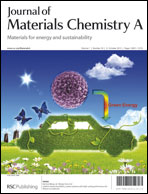Zwitterionic colloid particles (ZCPs), a novel type of membrane material endowed with tunable selectivity and improved antifouling properties, were synthesized from 3-dimethyl(methacryloyloxyethyl) ammonium propane sulfonate (DMAPS) and 2-hydroxyethyl acrylate (HEA) by means of aqueous free-radical polymerization. Atomic force microscopy and dynamic light scattering analyses indicated that the water dispersed ZCPs nanoparticles (300–600 nm) were formed owing to the competitive balance between the electrostatic attraction of DMAPS and the hydrophilic dispersion effect of HEA. As such, when the DMAPS content in ZCPs was selected in the range of 19.4 to 37.1 mol%, ZCP membranes (ZCPMs) were prepared via surface coating, followed by glutaraldehyde crosslinking at 50 °C for 3 h. The ZCPMs have a good separation performance to organic molecules (polyethylene glycol, PEG) and inorganic salts (Na2SO4). For example, the average rejection of ZCPMs to PEG1000, PEG600, PEG200 and Na2SO4 is about 96%, 88%, 60%, and 20%, respectively. Noteworthy, the nanostructures of ZCPs and their membrane performances could be conveniently adjusted by tuning the monomer ratio in copolymerization, the H2SO4 concentration in the casting solution and the pH value of the feed solution. Furthermore, by using humic acid and bovine serum album as model organic foulant molecules, the antifouling properties of ZCPMs proved to be excellent as exemplified by the stable water flux and salt rejection versus filtration time.


 Please wait while we load your content...
Please wait while we load your content...